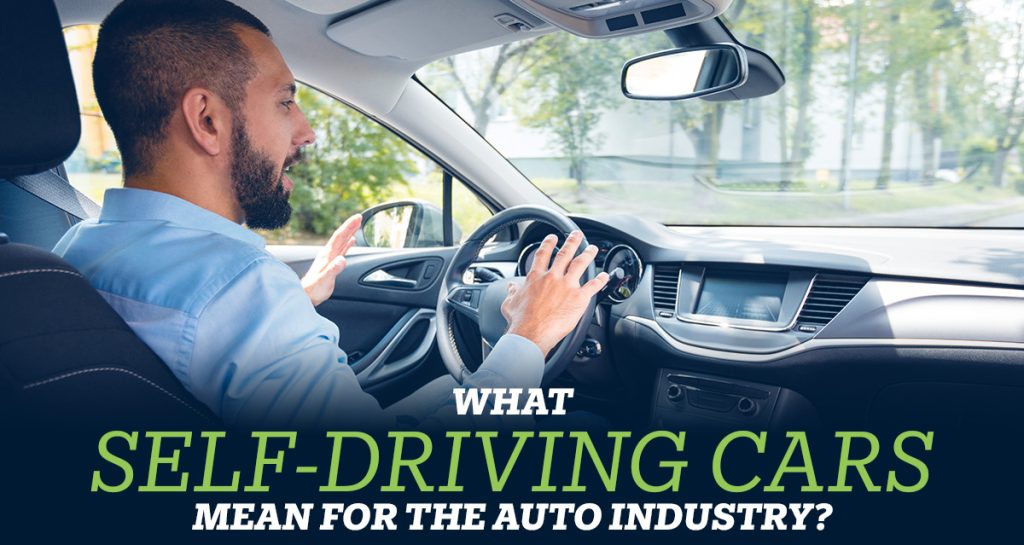Only a few short decades ago, the idea of driverless cars seemed like something conjured up out of a Steven Spielberg or George Lucas movie. Strictly speaking, self-driving technology has been around for quite some time and began with the invention of standard automobile features like cruise control. Fast forward to 2020, and cars that drive themselves (A.K.A. autonomous vehicles) are more science than science fiction and have the potential to change the face of the auto industry as we know it. Are you ready for a future that doesn’t put you in the driver’s seat?
Whether you love or hate the idea of self-driving cars, it’s hard to argue with some of the latest advances coming off the assembly line. After all, automated functions like – autonomous lane-assist, automatic forward-collision braking, lane correction – all increase the safety of both drivers and passengers. And if you completely remove the primary reason for collisions – human error, it certainly could make for a safer transportation environment. But to fully understand the impact of completely self-driving cars hitting the roadways, let’s start by identifying the different levels of autonomous vehicles.
Levels of Autonomous Cars
The Society of Automotive Engineers (SAE) has classified vehicles with autonomous features based on the level of “self-driving” it is capable of doing. The levels below outline the differences between zero autonomy and a fully autonomous car.
Level 0 – The driver is responsible for all core driving tasks. However, Level 0 vehicles may still include features like automatic emergency braking, blind-spot warnings, and lane-departure warnings.
Level 1 – Vehicle navigation is controlled by the driver, but driver-assist features like lane centering or adaptive cruise control are included.
Level 2 – Core vehicle is still controlled by the driver, but the vehicle is capable of using assisted-driving features like lane centering and adaptive cruise control simultaneously.
Level 3 – Driver is still required but is not needed to navigate or monitor the environment if specific criteria are met. However, the driver must remain ready to resume control of the vehicle once the conditions permitting ADS are no longer met.
Level 4 – The vehicle can carry out all driving functions and does not require that the driver remain ready to take control of navigation. However, the quality of the ADS navigation may decline under certain conditions such as off-road driving or other types of abnormal or hazardous situations. The driver may have the option to control the vehicle.
Level 5 – The ADS system is advanced enough that the vehicle can carry out all driving functions no matter the conditions. The driver may have the option to control the vehicle.
Impact on the Auto Industry
The assumption is that an influx of level 4 and 5 self-driving cars would mean fewer people would actually own cars. And that could lead to a decline in car sales, which in turn, could have an economic impact on the auto industry. After all, a fleet of self-driving cars at the ready you could summon as easily as you summon an Uber would surely persuade some people to forego the expense of a personal vehicle. Especially given the other benefits. Fewer cars on the road, fewer accidents and less pollution in the atmosphere. It sounds like a win-win unless you’re a car manufacturer or dealer.
Some industry insiders also suggest the industry could be affected by a substantial increase in the cost of manufacturing due to the cost of advanced AI technology and other technologies.
But there are other industries that could be impacted should car sales decline and manufacturing costs increase. Auto insurers would face fewer claims and rates would fall – which is good but not if you work for Geico. Oh yeah, and a mass rollout of self-driving cars is sure to affect you if you actually drive a taxi or work for a ride-sharing service. Gas stations, trucking companies – virtually any part of the transportation industry could be impacted. Will the pros outweigh the cons? Will the auto industry adapt? That remains to be seen.
One thing is certain, though – regardless of how cars are being driven – by humans or artificial intelligence, they will always need maintenance, service and repairs performed by qualified technicians. So, if you are considering a future in the automotive industry and like the idea of being a part of the exciting advances in automotive technology coming soon to a roadway near you – you should check out the programs at J-Tech Institute. J-Tech is training the next generation of talented automotive and diesel technicians. Contact us today to learn more or to schedule your visit at our 168,000 square foot facility in Jacksonville, FL.
